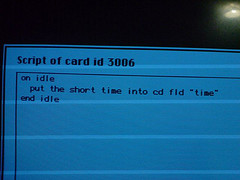 David Weinberger reminded me that today is the 25th anniversary of HyperCard, the hypermedia technology launched by Apple before the Web existed.
David Weinberger reminded me that today is the 25th anniversary of HyperCard, the hypermedia technology launched by Apple before the Web existed.
I was an enthusiastic user of HyperCard. At UC Berkeley I pulled together a group that created a library orientation guide for the very large and distributed library system on that campus. I also created a conference guide for the 1987 California Library Association Conference since my boss at the time was the President of the association and was presiding over the conference. I worked so hard to get it ready that I was sick during the conference and had to miss most of it.
The beauty of Hypercard was HyperTalk, the programming language you used to control what the “cards” (or screens) did in your “stack”. For example, you could program a button so when someone clicked on it it would take you to another card. Call it the Web without the network.
Launched in 1987, HyperCard was all but dead by 1993 when Mosaic hit the streets and overnight made the Web THE place to do hypermedia. Do I regret all the time spent using a technology that really only lived for the blink of an eye? Not on your life.
HyperCard was where I learned how to DO the Web. It was where I learned the importance of screen real estate. It was where I learned the law of 7, plus or minus 2. It was where I learned how important graphics are in creating an engaging site. It was where I cut my teeth on interactivity.
In some ways I miss it still. HyperTalk remains one of the easiest programming languages I’ve ever learned, since it’s style was about as close to plain English as a language can get. So yes, I mourn it’s passing and I remember it fondly. If you were there, back in the day, perhaps you do too.
Photo by Karl Baron, Creative Commons License Attribution 2.0 Generic


Cool! I too cut my teeth on hypertext using HyperCard. Specifically, I wrote a program I called HyperNote allowing a person to annotate text with words, pictures, and links to other application. It was pretty much fun, especially considering that I wrote it in 1992 or so — http://infomotions.com/musings/hypernote/
Thanks for the reminiscence, Roy. My wife and I put together a Maya Calendar Stack on our Mac SE, which looks primitive now (both the stack and the computer), but was one of the first to interactively show how things worked calendrically, way back in the late ’80s. We won a Mac LC II in an Apple stack contest with it, and I went on to conquer the French Republican Calendar. Can still run them on the final release of Hypercard on an orange clamshell Mac ibook.